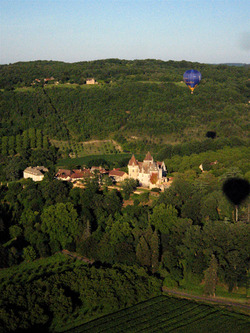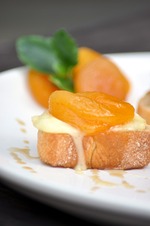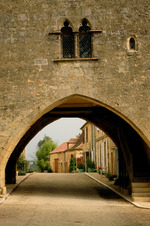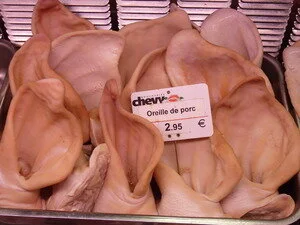words + pictures by Kimberley Lovato
Dreams are often born from the most unsuspecting places. Incredibly, mine happened to be delivered by an editor. The assignment that landed in my lap was to head to the Dordogne region of France and follow a chef and her new culinary tour company guests around for a week. No convincing needed, I immediately got in my car in Brussels and drove 10 hours south. En route I stopped to fuel up and a postcard caught my eye. A picturesque village was enveloped in fog and huddled against a cliff at the edge of the Dordogne River, with a dilapidated rowboat tied to its shore. On the back of the card, in small black and white print, were the words, La-Roque-Gageac, Dordogne. If fairy tales were depicted on postcards, they would look like this. I bought the card and tucked it behind the visor of my car.
 I arrived in Biron, a village of 140 people, at an old priory that sits in the shadows of a 500-year -old castle. I recall knocking on the weathered wooden doors of the Priory, and hearing the metal against metal slide of the bolt behind it, then a slow creek as the door opened. Half expecting Frankenstein, I was greeted, instead, by the face of my host, Florida based Chef Laura Schmalhorst. Since then, Laura and I have met up in the Dordogne every year, bonded by our love of a good adventure, good food and wine, and seduced by the convivial people, their passion for the food and their willingness to share it and their stories with us.
I arrived in Biron, a village of 140 people, at an old priory that sits in the shadows of a 500-year -old castle. I recall knocking on the weathered wooden doors of the Priory, and hearing the metal against metal slide of the bolt behind it, then a slow creek as the door opened. Half expecting Frankenstein, I was greeted, instead, by the face of my host, Florida based Chef Laura Schmalhorst. Since then, Laura and I have met up in the Dordogne every year, bonded by our love of a good adventure, good food and wine, and seduced by the convivial people, their passion for the food and their willingness to share it and their stories with us.
While I prefer to travel by bus or local rickshaw, in the Dordogne, a car is essential. The 2-lane roads are well marked but signs can be miniscule, especially the hand-painted ones directing you to local farms. Be warned: some signs, like those of a walnut farm I was seeking, lead you like Hansel and Gretel’s breadcrumbs only to completely disappear. I have learned not to get worked up over this loss of time. We as Americans are programmed for efficiency and if we don’t get where we are going in a reasonable time, our springs pop out and the brain shuts down, reducing us to cursing, yelling idiots. In the Dordogne, time itself is on vacation. When you live in a fairytale there is no reason to rush, someone once told me. Sometimes it’s good to get off the time track, or be knocked off.
For those used to schedules, I offer these helpful translations when visiting the Dordogne :
Dordogne speak Translation
It’s only 20 minutes away = It’s 40 minutes away
Get to the market early = Before 7:30 a.m. if you hope
to park within 1 mile and
actually get to see food
“I’ll arrive at 10 a.m.” =I’ll arrive sometime after 10
(insert any time here)
We’d like lunch quickly, = Does not translate
we’re in a hurry
 Although time is not of the essence in the Dordogne, learning not to take it personally is. A delay in taking an order, a long line, or not honoring an appointment to the minute is not a slam against you. It’s simply the way it is. I also learned never to plan a meeting on a Sunday. Sundays in France are sacred and reserved for the market, family, church, or a mid-day meal. It also didn’t take ME long to figure out that a ‘quick bite’ does not exist, and no matter when I arrived at A restaurant, I left two hours later just like everyone else. Let’s face it, France is a slow food nation and meals are carefully prepared and savored, not served in a cardboard box from a clown’s mouth to be eaten on the road. Once Laura and I became aware of this, we tossed our watches, became sign literate and, with serendipity as our guide, we really started to enjoy ourselves.
Although time is not of the essence in the Dordogne, learning not to take it personally is. A delay in taking an order, a long line, or not honoring an appointment to the minute is not a slam against you. It’s simply the way it is. I also learned never to plan a meeting on a Sunday. Sundays in France are sacred and reserved for the market, family, church, or a mid-day meal. It also didn’t take ME long to figure out that a ‘quick bite’ does not exist, and no matter when I arrived at A restaurant, I left two hours later just like everyone else. Let’s face it, France is a slow food nation and meals are carefully prepared and savored, not served in a cardboard box from a clown’s mouth to be eaten on the road. Once Laura and I became aware of this, we tossed our watches, became sign literate and, with serendipity as our guide, we really started to enjoy ourselves.
Along our aimless path we discovered a land of unspoiled beauty that spoiled us rotten. Nothing can replicate the awe of seeing for the first time a 500-year-old castle carved into a cliff overlooking the Dordogne River, or be more inspiring than five generations of family working side by side IN their ancestral winery. Every nook and cranny of the Dordogne, every person whose paths we crossed, deepened our appreciation of the diverse landscapes and regional history. My camera was put into overdrive but the pictures could never quite capture the essence of what I saw. How do you photograph the footsteps of prehistoric man? The grottos and the cliff-side caves where traces of history date back 500,000 years? Can a picture of a war memorial do justice to the memories of men who left their tiny Dordogne village and never returned home?
 We were easily seduced by the fairy tale scenery, but realized it was merely foreplay to encountering the personalities behind the ancient doors. After years of frequenting the same hotels, restaurants, farms, shops and daily markets, chef Laura and I slowly got to know the families, and we were invited into their homes and kitchens. From those with deeply seeded roots in the Périgord to those building a new life in the region, there is a common thread amongst them: passion. Sitting down at the table with these bon vivants revealed more in one dinner than all the wrinkled maps and glossy guidebooks ever told me. A young Dordogne chef, after serving us a simple meal of duck confit, said “All the major events of my life happened around this kitchen.” It was a revelation for us.
We were easily seduced by the fairy tale scenery, but realized it was merely foreplay to encountering the personalities behind the ancient doors. After years of frequenting the same hotels, restaurants, farms, shops and daily markets, chef Laura and I slowly got to know the families, and we were invited into their homes and kitchens. From those with deeply seeded roots in the Périgord to those building a new life in the region, there is a common thread amongst them: passion. Sitting down at the table with these bon vivants revealed more in one dinner than all the wrinkled maps and glossy guidebooks ever told me. A young Dordogne chef, after serving us a simple meal of duck confit, said “All the major events of my life happened around this kitchen.” It was a revelation for us.
Food is culturally significant in France. Days are planned around meals, shops are closed from noon to 2 p.m. for lunch, Sundays are reserved for a big meal with friends and family, and colloquial expressions related to food are pervasive. I documented about 100. One of my favorites, écraser le champignon, literally means crush the mushroom (sounds kind of kinky when I say it out loud) but means “Step on it! Put the pedal to the metal”. I find this amusing since no one ever hurries in the Dordogne. And perhaps the expression that resonated the most was Vous avez du pain sur la planche, literally translates you have some bread on your plank, but meaning, “You have your work cut out for you”. Language is also important in the Dordogne, as it is wherever you travel. I find it critical to be able to say four key words: Hello, Goodbye, Please, and Thank You. A smile accompanied by a genuine bonjour (hello) and merci (thank you) goes a long way and encourages the recipient to respond in kind. Nothing surprised me more than meeting a truffle farmer, from the middle of what could have been 200 miles east of Timbuktu, who spoke to us, willingly, in perfect English. Even today, the Dordogne and its people continue to charm me. That’s why I keep returning.
By the way, I found the image on the card that tempted me all those years ago. Laura and I were driving along the river when suddenly there it was, La-Roque-Gageac. There was even a worn rowboat slapping against the shore. The postcard had become creased with age, but the image before me was fresh, detailed and magical, the way a fair tale should be.
Kimberley Lovato is a freelance travel writer and the author of Walnut Wine & Truffle Groves, a culinary travel book about her adventures in the Dordogne. See her website for more details and order information. www.kimberleylovato.com

